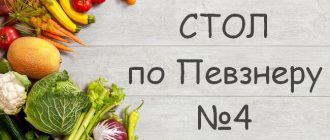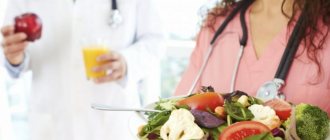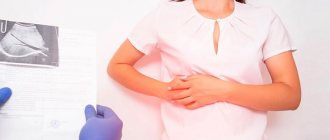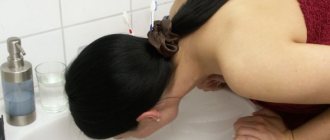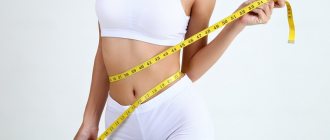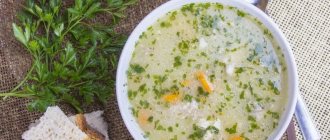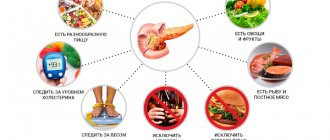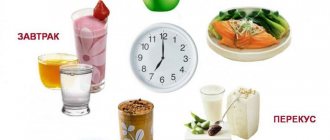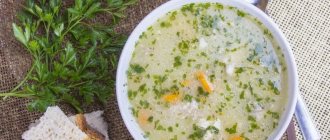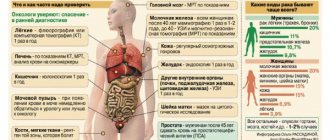11/25/2019 Article
- general characteristics
- Table "Do's and Don'ts"
- Menu for the week
- Diet modifications Diet “Table 4A”
- Diet "Table 4B"
- Diet "Table 4B"
- Diet for children
The “4 table” diet is indicated for acute intestinal diseases and exacerbations during the period of ongoing diarrhea. The goal of the diet is to provide the body with the necessary nutrients without irritating the intestines or causing fermentation in it. “Table 4” refers to strict medical diets; it is prescribed during periods of exacerbation of dyspeptic disorders, chronic intestinal diseases and after operations.
Medicines at affordable prices. A large assortment. Order now!
Antidiarrheal drugs
General rules
Let's figure out what a therapeutic diet is.
Nutritional therapy is prescribed for various diseases and is a mandatory method of therapy. In some cases, this is the only or primary method of treatment. The founder of dietetics M.I. Pevzner, who developed the basics of therapeutic nutrition, wrote that in its absence there is no rational treatment. For each disease, a specific table is assigned. Thus, Table No. 4 (Diet No. 4 according to Pevzner) is prescribed for intestinal diseases that occur with diarrhea . The purpose of its administration in this condition is to reduce inflammation, fermentation and putrefactive processes that predominate in this case. It protects the intestines and helps normalize digestion.
Due to the reduction of fats (up to 70 g) and carbohydrates (250 g), it has a reduced energy value. Daily calorie content is 2000 kcal. At the same time, the normal protein content (90 g) is maintained. All kinds of intestinal irritants are significantly limited: mechanical, chemical and thermal.
Products that enhance secretion, fermentation and putrefaction processes, stimulants of bile secretion, secretion of gastric juice and pancreas are excluded. Dishes are boiled or steamed, served in a liquid, semi-liquid or mashed state. Very hot and cold foods are excluded. Salt is allowed in the amount of 8-10 g, the water regime is 1.5-2 liters per day. Meals are provided up to 5-6 times a day, in fractional portions and warm.
The basic rules are:
- six meals a day, the basis of which are mashed, pureed, mushy dishes, slimy soups;
- boiled and steam cooking methods;
- Hard, thick, hot and cold foods are prohibited.
Chemical composition and energy value of dietary table No. 4
Proteins: 85 g (60% animal proteins). Fats: 70 g. Carbohydrates: 250 g (no more than 40 g of simple carbohydrates). Daily calorie content: 1,800 – 2,000 kcal. Free liquid: 1.5 l. Table salt: 6 g. Vitamins: retinol (A) – 2 mg, riboflavin (B2) – 4 mg, thiamine (B1) – 4 mg, nicotinic acid (B3) – 30 mg, ascorbic acid (C) – 100 mg. Macroelements: calcium – 0.8 g, magnesium – 0.5 g, phosphorus – 1.6 g. Microelements: iron – 15 mg. Optimal food temperature: from 20 to 55 degrees Celsius.
Varieties
The varieties are Diets 4A , 4B , 4B , which have differences in the set of permitted products and other indications for use. Thus, table 4B is prescribed during a period of improvement or during mild exacerbation of chronic intestinal diseases. Contains more proteins (100-110 g), fats (100 g) and carbohydrates (400-420 g). Has high energy intensity (up to 3000 kcal). The diet remains the same, but the list of permitted foods has been expanded: vermicelli, noodles, carrots, potatoes, cauliflower, zucchini, cream, sour cream, kefir, sweet berries and fruits.
Table 4B is indicated during the period of recovery and transition to normal nutrition. Contains the same amount of proteins, fats (vegetables are already included) and carbohydrates. The list of permitted products has been significantly expanded: buns, pies, cabbage, green peas, beets, doctor's sausage, dairy, ham, oranges, grapes, tangerines, strawberries, watermelon, raspberries, vegetable oil, and the amount of butter has been increased to 15 g per dish.
Diet modifications
In addition to the main diet, there are several variations.
Diet "Table 4A"
Diet “Table 4A” is a diet prescribed for celiac disease, steatorrhea, colitis with the presence of fermentation processes. It is distinguished by a higher amount of protein and calcium contained, the exclusion from the diet of cereal products (bread, cereals, flour products) and products that have a negative effect on liver function.
Diet "Table 4B"
The “Table 4B” diet is prescribed for:
- not a sharp exacerbation of intestinal diseases (colitis, enterocolitis),
- during the period of oncoming recovery in acute form of enterocolitis,
- when accompanied by the listed conditions with diseases of the pancreas, biliary tract, liver and stomach.
The diet is similar to the main diet, but allows the use of:
- dry biscuits, savory buns and pies;
- black caviar, boiled pasta, mild cheeses;
- boiled pureed vegetables: zucchini, zucchini, pumpkin, cauliflower and fresh tomatoes;
- marshmallows, marshmallows, marmalade, jam;
- aromatic herbs: dill and parsley;
- seasonings: bay leaf, vanilla, cinnamon;
- fruits: strawberries, pears, tangerines and apples.
After the “Table 4B” diet, they move on to “Table 4B” or to a regular diet.
Diet "Table 4B"
The “Table 4B” diet is a special diet prescribed during the period of remission and recovery for chronic or acute forms of enterocolitis, infectious and other intestinal diseases. A characteristic feature of the diet: eating food in a non-chopped state, limiting fried foods.
The list of consumed products is expanding: buns with cottage cheese, doctor's or milk sausage, sausages, soaked herring, kefir, fermented baked milk, refined vegetable oil, ripe fruits, beets, tomato juice, compotes.
Diet for children
The “4 table” diet for children is used in case of exacerbation of intestinal diseases in children. It is distinguished by the consumption of large quantities of mineral water, herbal teas, and compotes. Otherwise, the same recommendations apply as for adults.
See also:
- Sanatoriums with gastrointestinal treatment
- Diet “1 table” for gastritis, gastric ulcer and intestinal ulcer
- Diet “2 table” for gastritis
- Diet "3 table" for constipation
- Diet “5 table” for diseases of the liver, biliary tract and gall bladder
- Diet “15 table” for diseases that do not require special therapeutic diets
Save the link:
Authorized Products
Dietary food at this table involves the use of dried wheat bread or crackers. You can eat 200 g of thinly sliced and not very fried crackers per day. Unsweetened dry cookies are allowed.
Porridge is the main product
The basis of the diet is pureed porridge from semolina, rice (white rice), buckwheat and oatmeal, which are prepared in water or broth (low-fat). Butter is added in the amount of 5 g per serving, per day - 50 g.
Soups are also prepared with low-fat and non-rich fish or meat broth, adding permitted cereals, a minimum of vegetables, boiled and pureed meat, quenelles, egg flakes, meatballs, etc.
The fourth table involves the consumption of lean and lean varieties of beef, chicken, turkey, veal, and rabbits. To do this, the meat is additionally degreased, and the tendons and skin of the bird are removed.
Steam cutlets, soufflé or meatballs are prepared. They can also be stewed in a saucepan over water. When preparing cutlets, boiled rice or semolina is placed in the minced meat instead of bread. You can make pate from boiled meat with a minimum of salt.
Low-fat varieties of fish are prepared in pieces or chopped in the form of quenelles, cutlets and meatballs. They can also be cooked by steaming or in water. 1-2 eggs per day are allowed, which are cooked soft-boiled or steamed omelettes, added to soufflés and soups.
As for cottage cheese, it should be unleavened (non-acidic) and mashed; you can use it to make steamed soufflés and casseroles. Vegetables are eaten only as a pureed addition to soups and in small quantities.
Mashed raw apples, applesauce, berry jelly from blueberries, dogwood, quince, bird cherry, pears and fruit drinks are allowed. If well tolerated, you can drink diluted fresh juices from non-acidic berries (diluted 1:1 with water). The exceptions are grape, apricot and plum juices. Herbal tea, rosehip decoction, bird cherry infusion, dried dogwood, blueberries, green and black tea, still water up to 1.5 liters per day are allowed.
Table of permitted products
| Proteins, g | Fats, g | Carbohydrates, g | Calories, kcal | |
Fruits | ||||
| quince | 0,6 | 0,5 | 9,8 | 40 |
| pears | 0,4 | 0,3 | 10,9 | 42 |
| apples | 0,4 | 0,4 | 9,8 | 47 |
Nuts and dried fruits | ||||
| dried pears | 2,3 | 0,6 | 62,6 | 249 |
Cereals and porridges | ||||
| buckwheat (kernel) | 12,6 | 3,3 | 62,1 | 313 |
| semolina | 10,3 | 1,0 | 73,3 | 328 |
| oat groats | 12,3 | 6,1 | 59,5 | 342 |
| cereals | 11,9 | 7,2 | 69,3 | 366 |
| white rice | 6,7 | 0,7 | 78,9 | 344 |
Bakery products | ||||
| white bread crackers | 11,2 | 1,4 | 72,2 | 331 |
Confectionery | ||||
| Maria cookies | 8,7 | 8,8 | 70,9 | 400 |
Dairy | ||||
| skim milk | 2,0 | 0,1 | 4,8 | 31 |
| acidophilus | 2,8 | 3,2 | 3,8 | 57 |
Cheeses and cottage cheese | ||||
| cottage cheese 0.6% (low fat) | 18,0 | 0,6 | 1,8 | 88 |
Meat products | ||||
| boiled beef | 25,8 | 16,8 | 0,0 | 254 |
| boiled veal | 30,7 | 0,9 | 0,0 | 131 |
| rabbit | 21,0 | 8,0 | 0,0 | 156 |
Bird | ||||
| boiled chicken | 25,2 | 7,4 | 0,0 | 170 |
| turkey | 19,2 | 0,7 | 0,0 | 84 |
Oils and fats | ||||
| butter | 0,5 | 82,5 | 0,8 | 748 |
Non-alcoholic drinks | ||||
| mineral water | 0,0 | 0,0 | 0,0 | — |
| green tea | 0,0 | 0,0 | 0,0 | — |
| black tea | 20,0 | 5,1 | 6,9 | 152 |
| * data is per 100 g of product | ||||
What food do doctors recommend eating on the “Table No. 4” diet?
With the “Table No. 4” diet, we eat the following food:
- Steamed or, as usual, in water, ground young beef, turkey, chicken, rabbit
- Fish (pollock, sea and river perch, pike, pike perch, hake), boiled in small slices in water, or ground and steamed
- Weakly boiled eggs with a runny yolk or steam omelette - no more than 1 piece per day
- White stale bread, white crackers, dried in the oven or dry cookies, no more than 200 g per day
- Vegetables after a steam bath, or cooked in the usual way in water, and pureed
- Well-digested porridge (buckwheat, oatmeal, rice, semolina) in water
- Oven baked apples
- Kissels, juices half with water from sweet and astringent berries and fruits (blueberries, blueberries, pears, dogwoods, black currants, quinces)
- Green and black teas, from medicinal dried fruits and herbs (rose hips, bird cherry, chamomile, blueberries)
- Chicory coffee drink
- Non-carbonated mineral water
With the “Table No. 4” diet, we eat, but not much.:
- Infrequently - cottage cheese, low-fat kefir and porridge with milk half and half with water
- Butter - no more than 50 g per day
- Vegetable oil - no more than 5 mg per day
- Sugar for sweetening cereals and tea - no more than 50 g per day
- A little dry herbs (dill, cilantro, parsley) - in the soup
With the “Table No. 4” diet, you can eat
Fully or partially limited products
Diet number 4 for the intestines is based on the exclusion of foods containing fiber. In this regard, vegetables are excluded (can be decoctions or added to soup), bran, whole grain, rye and bran bread with the addition of seeds and cereals, which additionally injure the intestinal mucosa and are poorly digested.
Fresh bread, pastries, pancakes and pancakes cause fermentation and rotting in the intestines and are therefore prohibited. For the same reason, jam, dried fruits, honey, jams and other sweets are not allowed, and sugar is allowed in a limited amount of 50 g per day (in all dishes).
Porridges made from millet, barley, pearl barley, legumes and pasta are coarse and poorly digestible foods that must be excluded during the period of exacerbation of the disease.
Rich fatty broths that enhance intestinal motility, fatty meats, sausages, fatty fish, canned food and salted fish are also prohibited.
Whole milk, sour cream, cream and cheese can cause increased diarrhea . Milk is used only in diluted form when preparing porridges and puddings.
Cocoa and coffee with milk, kvass, carbonated drinks that increase intestinal motility and bloating are unacceptable for these diseases. You cannot eat sauces and marinades, smoked meats, sausages, or ham.
Table of prohibited products
| Proteins, g | Fats, g | Carbohydrates, g | Calories, kcal | |
Vegetables and greens | ||||
| vegetables | 2,5 | 0,3 | 7,0 | 35 |
| vegetables legumes | 9,1 | 1,6 | 27,0 | 168 |
| potato | 2,0 | 0,4 | 18,1 | 80 |
| horseradish | 3,2 | 0,4 | 10,5 | 56 |
Fruits | ||||
| bananas | 1,5 | 0,2 | 21,8 | 95 |
| melon | 0,6 | 0,3 | 7,4 | 33 |
Berries | ||||
| grape | 0,6 | 0,2 | 16,8 | 65 |
Mushrooms | ||||
| mushrooms | 3,5 | 2,0 | 2,5 | 30 |
Nuts and dried fruits | ||||
| dried fruits | 2,3 | 0,6 | 68,2 | 286 |
Cereals and porridges | ||||
| pearl barley | 9,3 | 1,1 | 73,7 | 320 |
| Wheat groats | 11,5 | 1,3 | 62,0 | 316 |
| millet cereal | 11,5 | 3,3 | 69,3 | 348 |
| barley grits | 10,4 | 1,3 | 66,3 | 324 |
Flour and pasta | ||||
| pasta | 10,4 | 1,1 | 69,7 | 337 |
Confectionery | ||||
| jam | 0,3 | 0,2 | 63,0 | 263 |
| jam | 0,3 | 0,1 | 56,0 | 238 |
| candies | 4,3 | 19,8 | 67,5 | 453 |
| cookie | 7,5 | 11,8 | 74,9 | 417 |
Ice cream | ||||
| ice cream | 3,7 | 6,9 | 22,1 | 189 |
Cakes | ||||
| cake | 4,4 | 23,4 | 45,2 | 407 |
Raw materials and seasonings | ||||
| seasonings | 7,0 | 1,9 | 26,0 | 149 |
| mustard | 5,7 | 6,4 | 22,0 | 162 |
Dairy | ||||
| kefir | 3,4 | 2,0 | 4,7 | 51 |
| sour cream | 2,8 | 20,0 | 3,2 | 206 |
Cheeses and cottage cheese | ||||
| cheese | 24,1 | 29,5 | 0,3 | 363 |
Meat products | ||||
| pork | 16,0 | 21,6 | 0,0 | 259 |
| ham | 22,6 | 20,9 | 0,0 | 279 |
Sausages | ||||
| boiled sausage | 13,7 | 22,8 | 0,0 | 260 |
| dry-cured sausage | 24,1 | 38,3 | 1,0 | 455 |
| sausages | 10,1 | 31,6 | 1,9 | 332 |
| sausages | 12,3 | 25,3 | 0,0 | 277 |
Bird | ||||
| duck | 16,5 | 61,2 | 0,0 | 346 |
| goose | 16,1 | 33,3 | 0,0 | 364 |
Fish and seafood | ||||
| dried fish | 17,5 | 4,6 | 0,0 | 139 |
| smoked fish | 26,8 | 9,9 | 0,0 | 196 |
| canned fish | 17,5 | 2,0 | 0,0 | 88 |
Oils and fats | ||||
| vegetable oil | 0,0 | 99,0 | 0,0 | 899 |
| animal fat | 0,0 | 99,7 | 0,0 | 897 |
| cooking fat | 0,0 | 99,7 | 0,0 | 897 |
Non-alcoholic drinks | ||||
| bread kvass | 0,2 | 0,0 | 5,2 | 27 |
Juices and compotes | ||||
| juice | 0,3 | 0,1 | 9,2 | 40 |
| * data is per 100 g of product | ||||
What food should you not eat on the Table No. 4 diet?
What do you need to do without when following the “Table No. 4” diet?
- Without meat (pork, goose, duck)
- Without fish (herring, mackerel, red fish)
- No fried, raw, hard-boiled eggs
- Without rye bread and coarse bread with bran, pancakes, buns, cakes
- Without dairy (sour cream, cream and milk) fatty products
- Without heat-treated vegetables and fruits
- Without fruits and berries with acid
- Without coarse porridges (millet, pearl barley and barley)
- No legumes except green peas
- No dried fruits
- Without honey and jam
- Without carbonated drinks, kvass, cocoa, coffee
- Without all kinds of semi-finished products
- No canned foods
- Without sausages and various smoked meats
According to the “Table No. 4” diet, you cannot eat such food
Menu (Power Mode)
It is necessary to organize 6 meals a day and so that the 4th table for the week includes alternating a variety of protein dishes (beef, chicken, fish, rabbit, turkey, cottage cheese) and cereals, and egg dishes daily.
Below is an approximate menu for week of diet No. 4, which can be modified at will, however, the basic principles regarding the set of permitted foods and their heat treatment remain unchanged.
Monday
| Breakfast |
|
| Lunch |
|
| Dinner |
|
| Afternoon snack |
|
| Dinner |
|
| For the night |
|
Tuesday
| Breakfast |
|
| Lunch |
|
| Dinner |
|
| Afternoon snack |
|
| Dinner |
|
| For the night |
|
Wednesday
| Breakfast |
|
| Lunch |
|
| Dinner |
|
| Afternoon snack |
|
| Dinner |
|
| For the night |
|
Thursday
| Breakfast |
|
| Lunch |
|
| Dinner |
|
| Afternoon snack |
|
| Dinner |
|
| For the night |
|
Friday
| Breakfast |
|
| Lunch |
|
| Dinner |
|
| Afternoon snack |
|
| Dinner |
|
| For the night |
|
Saturday
| Breakfast |
|
| Lunch |
|
| Dinner |
|
| Afternoon snack |
|
| Dinner |
|
| For the night |
|
Sunday
| Breakfast |
|
| Lunch |
|
| Dinner |
|
| Afternoon snack |
|
| Dinner |
|
| For the night |
|
Diet “Table No. 4”: dessert
For desserts, the “Table No. 4” diet recommends casseroles, puddings, steamed, over a boiling pan or in a slow cooker.
Cheese casserole
Let's take the casserole:
- 150 g low-fat cottage cheese
- 1 egg
- 1 tsp. semolina and sugar
- Pinch of salt
Cooking:
- Mix cottage cheese, egg yolk, semolina and sugar, grind.
- Beat the egg white with a pinch of salt with a mixer until stable foam.
- Add protein to curd dough.
- Transfer the cottage cheese mixture into a small, pre-greased pan. The shape should be smaller in size than the multicooker.
- Fill the multicooker bowl with 1 liter of boiling water, place the form with dough on top, close the lid, turn the multicooker to “Steam” mode, and cook for half an hour.
- Open the lid of the multicooker, let the casserole cool slightly and serve.
Cottage cheese casserole from a multicooker
Rosehip tea
For tea you need:
- 20 g rose hips
- 1 cup boiling water
- 1 tsp. Sahara
Cooking:
- Crush the dried rosehips with a knife, pour them into a saucepan, pour boiling water over them, and let them boil.
- Pour the contents of the saucepan into a thermos, let it brew for 4-5 hours, pour it into a cup, add sugar, let it cool a little, and drink warm tea.
So, now we know what people following the Table No. 4 diet can and cannot eat.
Diet 4th table recipes for the week
Here are some recipes.
Pike perch meatballs
Ingredients : 50 g water, 50 g rice, 15 g butter, salt, 300 g pike perch fillet.
Pike perch meatballs
Cooking steps . Cook a sticky porridge of white rice. Pass it together with the pike perch pulp through a meat grinder (preferably twice), add melted butter, a little salt and water. Beat the minced meat well and form into meatballs. Cook in a steamer or any device for steaming dishes.
Steamed hake fillet balls
Ingredients : one egg, 300 g hake fillet, 50 g semolina, salt.
Cooking steps . Pass the fillet through a meat grinder, add semolina (no need to boil it), salt, egg, mix and beat thoroughly. Cook the chopped meatballs in a double boiler.
Steamed beef cutlets
Ingredients : 700 g beef, 1 pc. onions, 2 chicken eggs, rice flour 100 g, salt.
Cooking steps . Pass the meat and onions through a meat grinder. Add egg, salt and rice flour. Knead the minced meat well and put it in the refrigerator for an hour. Form cutlets and place them in a steamer, having previously greased the bottom and walls with vegetable oil. Cook for 30 minutes.
Steam omelette
Ingredients : 2 chicken eggs, salt, 1.25 glasses of milk.
Steamed omelette
Cooking steps . Beat the eggs well with milk, add salt. Place a small container with the egg mixture in the multicooker bowl, greasing it with butter (vegetable) oil. Cook the omelette in the “steam” mode. If you don’t have a multicooker or a double boiler, you can organize a water bath: pour water into a saucepan with a thick bottom and place a container (glass or metal) with the egg mixture in it. Grease the omelette pan with oil and it is important that the bottom just touches the surface of the water. Cook over low heat for 35 minutes with the lid closed.
Buckwheat pudding with cottage cheese
Ingredients : 0.25 cups buckwheat, 150 g low-fat cottage cheese, one egg, 1 tsp sugar.
Buckwheat pudding with cottage cheese
Cooking steps . Prepare buckwheat porridge and puree it. Combine with cottage cheese, add yolk and sugar, mix thoroughly and lastly add well-beaten egg white. Place in a pan greased with butter and steam. Drizzle with melted butter.
Puree buckwheat porridge
Ingredients : 0.5 cups buckwheat, 2 cups water, salt, sugar 1 tsp, butter 5g.
Cooking steps . Prepare buckwheat porridge using more water than for preparing crumbly porridge. Boil with salt and rub it. Add sugar and butter to the finished dish.
Diet “Table No. 4”: first courses
According to the “Table No. 4” diet, we cook soups from vegetables and ground lean meat, and then puree the soup.
Puree soup with vegetables
In the soup we'll take:
- 2 medium potatoes and 2 sweet peppers each
- 1 medium sized zucchini and 1 carrot each
- 2-3 florets of broccoli
- 2-3 tbsp. l. green peas
- A little dry herbs (cilantro, dill, parsley, celery)
- Pinch of salt
- 1 tbsp. l. butter and low-fat cottage cheese
- 1 liter of water
Cooking:
- Place all vegetables (including greens), cut into pieces, except peas, into hot water and cook until the vegetables are softened (15-20 minutes).
- Place fresh green peas in a frying pan, add butter and cottage cheese, and simmer for 10-15 minutes.
- Beat the cooked and slightly cooled vegetables in a saucepan with a blender, add the stewed peas, add some salt, and serve the soup warm with white stale or oven-dried bread.
Puree vegetable soup with stale bread
Therapeutic diet 4th table for children
Used in the presence of diarrhea . On the first day, a fasting diet - the child is given only herbal teas and decoctions , and still Borjomi mineral water. The daily amount of liquid is no more than 1 liter, drink is given in fractions, often and in small portions, so as not to provoke vomiting. On the second day, they are transferred to this diet with meals at least 6 times a day.
The diet is no different from that of adults. The child is first given mucous infusions of rice, low-fat, non-cool chicken and beef broth, soups with the addition of oatmeal, semolina, and steamed fish and meat dishes. Ground meat or meatballs are added to soups. If the child eats porridge well, then pureed buckwheat, rice and oatmeal are prepared.
A steam omelet is prepared from eggs; a child can eat cottage cheese in its natural form or as steamed casseroles. Butter is used exclusively for dressing. Decoctions of blueberries, rose hips, quince and jelly are suitable drinks for children. During the day you can give crackers made from wheat bread.
Butter dough, vegetable and milk soups, smoked meats, canned food, sausages, and fatty meats are prohibited. You should not give your child sour cream, milk, vegetables of any kind, carbonated drinks, fresh fruit and grape juice.
After 6 days of dietary nutrition, the child, if necessary, is transferred to a more expanded Diet No. 4B. It allows some vegetables (zucchini, cauliflower, pumpkin, potatoes, carrots), which are added to soups, as well as small noodles. Porridge is prepared with a small amount of milk. It is allowed to add sour cream to dishes in small quantities.
Diets for various diseases
Many people in Russia (not abroad) are familiar with the M.I. Pevzner diet, recommended for various diseases. They have their own numbers, for example, diet No. 5 for liver diseases or table No. 10 for hypertension and heart disease. In modern dietetics, the Pevzner diet system is considered outdated. In his book “Rational and Medical Nutrition” in 1930, M. I. Pevzner proposed a group nutrition scheme that included 21 dietary tables (actually 15, some of which are divided into a, b, c).
Of course, Pevzner instilled in society the idea that a therapeutic diet is necessary for healing, for which we will always be grateful to him. But his diets were developed for hospitals and sanatoriums of the Soviet Union - both for the purpose of improving health and for the purpose of saving money. Pevzner wrote: “Individual therapeutic nutrition is an expensive pleasure, inaccessible to most people in a sanatorium or hospital. And to feed thousands and millions of people at that time, it was possible to offer only “group” meals, focused “on the disease, and not on a specific patient.”
Today the opposite principle prevails: we treat not a disease, but a patient who may have not one, but several health problems, and sometimes patients come to us with the question of what they should ultimately eat, because recommendations, for example, for constipation and diabetes coupled with coronary heart disease are mutually exclusive, leaving no permitted products. The answer lies not in reading diets verbatim, but in following the principles of therapeutic nutrition. In general, Pevzner tables can be represented as follows:
Table No. 0 After operations - baby food, we minimize mechanical irritation of the mucous membranes, facilitate the absorption of nutrients with a gradual expansion of the diet over the course of a month.
Table No. 1 Stomach diseases with high acidity - day-old bread, lean meat and fish, low-fat dairy products, cereals - rice, buckwheat, semolina are recommended, you can steam omelettes, boiled or baked vegetables, sweet fruits, fermented milk tan, ayran, unsweetened yogurt . Any spicy, highly salty or sour foods, fried foods, canned food and marinades are prohibited.
Table No. 2 Gastritis with low acidity - everything is possible except cabbage, legumes, buns, very fatty foods (avoid bloating).
Table No. 3 Constipation - yesterday's bread, fermented milk products, fresh vegetables and fruits are useful, if the stomach does not hurt, (or heat-treated - for intestinal spasms, since coarse fiber stimulates peristalsis, which can increase pain), dried fruits and compotes from them. Do not eat sour, fatty, spicy, hard-boiled eggs, or strong tea.
Table No. 4 Diarrhea - you can have soups, crackers, cereals - semolina, oatmeal, rice, buckwheat. Food should be free of spices, marinades, coarse fiber, fruits, vegetables, and legumes. Fermented milk products include yoghurt, cottage cheese, and cheese.
Table No. 5 Cholecystitis, pancreatitis - all food and drink should be warm to avoid spasms of the biliary tract. Avoid fatty, fried, smoked, cruciferous vegetables (cabbage, radishes, radishes, turnips), garlic. In case of bile stagnation, a mandatory meal before bed (to empty the gallbladder before the night peak of bile production). In case of acute inflammation of the pancreas - “cold, hunger and rest”, minimize food intake.
Table No. 6 Urolithiasis (urate in the urine) - alkalizing foods are good: dairy, vegetables. You can't eat legumes, smoked meats, or mushrooms. Limit meat, fish, fats, spices, cruciferous vegetables. When kidney stones and diarrhea are combined, vegetables must be heat-treated and milk replaced with the fermented milk product that is best tolerated (cottage cheese, cottage cheese).
Table No. 7 Nephritis - a milk-vegetable diet without fatty, spicy foods, and cruciferous vegetables are again excluded (the kidneys do not like white cabbage and meat, because they contain a lot of nitrogen, which must be actively removed).
Table No. 8 Obesity - counting calories! There are many diets, but they are all ineffective, because the main principle of losing weight is to consume less than you spend. All high-calorie foods are removed - fatty foods, simple carbohydrates (bread, rice, semolina) and sweets, incl. juices, limited to cheese. It is recommended to eat more vegetables to cleanse the intestines.
Table No. 9 Diabetes mellitus - all diabetics already know from the endocrinologist what they can and cannot do, the diet is explained to them at the time of diagnosis, because it is the most important aspect of treatment. White bread, rice, semolina are strictly prohibited (hard varieties of pasta and semolina are limited, red and brown rice are allowed) and, of course, everything sweet and fatty. If you combine diabetes with heart disease, you can still eat fish, but preferably not the fattest one. Beets, which are not accepted by everyone because of their sweetness, are introduced into the diet for constipation, as are dried fruits (prunes, figs, dried apricots) until stool normalization, but under strict glucose control.
Table No. 10 Heart and blood vessels - regarding the diet that prevents heart attacks and strokes, cardiologists and neurologists agreed in a common opinion: fatty sea fish and at least 400 g of vegetables per day are beneficial, but it is better to limit baked goods and animal fats. These recommendations contradict nutrition for diseases of the biliary tract, where fatty fish is not allowed, well, here you either take omega-3 in capsules (instead of fish), or “cover” the main dishes with enzymes (Creon) or choleretic drugs - depending on the clinical situation.
Table No. 11 Tuberculosis, exhaustion - to restore the body you need a lot of calories, meat is especially necessary, you can use spices and any methods of processing food. If exhaustion develops against the background of pancreatitis, the amount of food should be moderate, very frequent, but in small portions and always with enzyme preparations. If you are exhausted due to problems with blood vessels (for example, after a stroke), the diet should be varied, rich, but without animal fats.
Table No. 12 Neuroses - Pevzner considers only increased activity of the nervous system, therefore excludes “provocateurs” - smoked spices, pungency and sauces, sweets, however, for depressive disorders and general weakness, we recommend including “invigorating” foods in the diet - garlic, seasonings, ginger, ginseng, as well as dark chocolate, which has a proven antidepressant effect.
Table No. 13 Acute infectious diseases - a diet without “generally aggressive” foods, everything with the prefix “not too” (not too fatty, spicy, salty, spicy...)
Table No. 14 Urolithiasis (phosphates in the urine) - sour compotes, mushrooms, no pungent foods are good, limit vegetables, dairy products. This table, by the way, is directly opposite to the diet for gastritis - it means that we first reduce the acidity (for example, with pantoprazole), against the background of which we cure the kidneys, and then we adhere to a neutral diet (not acidic, not alkaline food).
Table No. 15 Almost healthy - bran, rye or oat bread, lean meat, offal, fish, seafood, all types of vegetables, herbs are recommended; sweet and sour varieties of fruits, berries, porridge, any pasta, any dairy products, vegetable and butter, natural homemade desserts, nuts, seeds. And chips, soda, smoked meats and sauces (mustard, ketchup, mayonnaise, Tabasco) are not good for anyone. This doesn't mean you can't, it means don't get carried away.
There are general trends in healthy eating in case of any illness and in their absence: meals should be varied, divided (4-5 times a day), include fruits and vegetables, meat and fish, bread and cereals. Oils, fats, and smoked spices are limited in almost any illness; it is better not to consume sauces and soda even if healthy, so that they remain so.
There can be no recommendations regarding each specific product, because, frankly, the effect on the body from ripe and unripe strawberries will vary more than from strawberries and tomatoes.
Not only products are important, but also their quality: for fruits, berries, vegetables - their ripeness, for meat and fish - their fat content, cooking methods, amount of seasonings. With a complete diet, no multivitamins or dietary supplements are needed. (Read the article about multivitamins >>)
So what should you put in your trolley at the supermarket?
1. Vegetables
- Potatoes, sweet potatoes, cauliflower, kohlrabi, broccoli, zucchini, zucchini, pumpkin, beets, carrots, onions, garlic, parsley and celery roots, fennel, parsnips, artichoke, rhubarb, asparagus - you can and should, but it is better to eat them thermally processed , especially for any digestive and stool disorders;
- white cabbage, radishes, radishes, turnips - not worth it if you have diseases of the kidneys or digestive organs, especially if you suffer from bloating;
- tomato, eggplant, pepper - not during exacerbations of gastrointestinal diseases, they can irritate damaged mucous membranes, it is better to eat without peel;
- legumes (green beans and legumes, lentils, peas, mung bean) - a source of protein for those who limit themselves to meat, it is important not to overuse it to avoid flatulence;
- Avocado is an excellent healthy vegetable, but it is fatty and is not recommended for diseases of the biliary tract.
2. Fruit
- sour apples, oranges, lime, lemon, kiwi, pineapple, exotic fruits - it is better not to take in case of exacerbation of gastritis or diarrhea, colitis;
- apricots, plums, dried fruits - perfectly cleanse the intestines
- bananas, sweet apples and pears, watermelon - if you don’t have diabetes, then live vitamins will be useful to everyone
- peaches, pomelo, mangoes, melons - if ripe, they are always good (Avicenna wrote about melons as a cure for many ailments);
- sour berries (fruit drinks) for urate kidney stones (not to be confused with phosphate stones!), not for acid gastritis and constipation.
Hand on heart, the effect on the body from ripe and unripe strawberries will vary more than from strawberries and tomatoes.
Not only products are important, but their quality: for fruits, berries, vegetables - their ripeness, for meat and fish - their fat content and cooking methods, incl. amount of seasonings 3. Greens
- Cucumber (yes, it is more of a green than a vegetable), leafy salads (Chinese cabbage, iceberg, watercress, arugula, etc.), a stalk of celery - fresh daily for everyone.
- Sorrel, spinach, sauerkraut - excluded in case of high acidity and urolithiasis.
4. Bread is better dried or in the form of toast.
It’s better not yeast, but sourdough. For gastritis and diarrhea, white is recommended; for constipation, rye or with bran; for diabetes and obesity, it is better to avoid it altogether. 5. Cereals, pasta White rice, soft semolina, couscous are the most high-calorie and safe for digestion, but they are not recommended for obesity and diabetes, buckwheat and oatmeal, bulgur and hard semolina are also useful for everyone, but pearl barley and millet It is better to cook cereals, red and brown rice outside of exacerbations of gastritis and colitis. Pasta made from durum wheat, as well as from rice and buckwheat flour, is suitable for everyone, even those who are losing weight.
6. Nuts, seeds Walnuts, hazelnuts, peanuts, pistachios, cashews, sunflower seeds, pumpkin seeds, flax seeds, sesame seeds - 30-50 grams per day (as much as fits in a handful), but limit in case of pathology of the biliary tract, because nuts and seeds are very fatty. Can be used as part of grain bread.
7. Oils
- up to 15 ml per day (1 teaspoon 3 times a day) for cholecystitis, pancreatitis, obesity, diabetes.
- up to 50 ml per day in the absence of the need to limit fat.
8. Fish
- Cod fish (cod, hake, pollock, haddock), flounder, perch, catfish and other sea fish should be a constant part of the diet.
- Herring, mackerel, fatty red fish (large trout, sea bass) - not worth it if you have pancreatitis, bile outflow disorder, no more than 150 mg per serving.
- Fish caviar contains a lot of fat, so it is limited in case of cholecystitis and pancreatitis. As a rule, it is highly salted, so if you have gastritis or stool problems, it is also better not to eat it.
9. Meat
- Chicken, turkey, quail, rabbit - recommended for everyone.
- Beef, lean pork - limited in case of any painful conditions, as “heavy” food, until recovery.
The older a person gets, the less red meat he needs.
Increased consumption of animal meat and liver is required for anemia and calcium deficiency. A fried meat crust is not at all healthy, because the phenols contained in the fried side of the cutlet can cause fatty liver, and eating kebab increases the risk of colorectal cancer. Eggs are good for everyone; they contain essential phospholipids (2 yolks contain more than 11 capsules of Essentiale), which normalize the flow of bile. Albumin (egg white) is allergenic, but very easily digestible. 10. Alcohol 1 serving of alcohol once a day is useful, especially in the evening and after meals - it improves blood circulation and prevents the formation of atherosclerotic plaques. True, this rule applies to those who already drink alcohol, but if you have never drank it, then you still shouldn’t start, because... the negative impact on an unprepared liver will outweigh the possible benefits.
1 serving of alcohol is 100 ml of wine for women and 150 ml for men or 30 ml of 40*drinks for women and 50 ml for men. As you drink more, the benefits do not increase, but the liver suffers. Beer has only a negative and multifaceted effect on the body, so it is better to avoid it altogether.
11. Coffee, tea Coffee is recommended by the World Health Organization in the amount of 3 cups of strong drink per day. It is slightly choleretic, so it is not recommended on an empty stomach (to avoid the reflux of bile into the stomach), only after breakfast. Both tea, especially black, and coffee, both brewed and instant, increase acidity, so if you have gastritis, it is better to avoid them.
12. Fermented milk products In our country, 80% of people cannot tolerate milk (stool disorder or allergies), kefir, yoghurt, fermented baked milk are well tolerated by half of the population, but an uncomfortable reaction to some fermented milk products does not mean the same for others. They contain different types of beneficial bacteria, each has its own dominant bacteria in the intestines, and you need the bacteria from yogurt to “make friends” with your native flora and suit a specific person, so the choice of these products is by trial.
Cheese is very high in calories due to fat and contributes to disruption of the outflow of bile, exacerbation of pancreatitis and constipation with large consumption. It is better to eat low-fat and low-salt cheeses, 50g per day. Cottage cheese is not so fatty, it is easier to tolerate, so it does not have such strict weight restrictions.
13. Harmful effects Mayonnaise and ketchup are strictly prohibited if you have pathology of the digestive system, and when possible, it is better not to overuse it. Everything is good in moderation.
Smoked sausages negatively affect the liver due to the content of phenols in them (like fried meat), and seasonings, which are present in large quantities in their composition, irritate the mucous membrane of the stomach and intestines. It’s better not to take them, but if you really want them, then at least boil them, not smoked.
Butter dough disrupts all known digestive processes and can only be consumed as a tasty treat, not often.
Sugar-based sweets without fat (marshmallows, marmalade, marshmallows) are not prohibited if there is no diabetes or obesity. Chocolates contain confectionery fats, the composition of which can often be scary, so the range of their possible negative effects is wide. But dark chocolate is healthy, and in moderate doses of 15 mg per day is even recommended.
Fruit juices are limited in case of high acidity (especially tomato and orange) and diabetes and obesity, because contain on average 13g of carbohydrates per 100ml of water, the same as 8 tablespoons of sugar per glass of tea. Carbonated drinks always increase acidity and tend to cause heartburn; they are especially strictly prohibited in case of ulcers, pancreatitis and gastroesophageal reflux disease.
The main thing is that food should bring not only benefits, but also joy. Eat deliciously and be healthy!
Advantages and disadvantages
| pros | Minuses |
|
|
For what diseases is the “Table No. 4” diet useful?
The “Table No. 4” diet will be beneficial, if followed, in case of illness:
- Colitis (inflammatory conditions of the large intestine)
- Enterocolitis (inflammatory conditions of the large and small intestines)
- Gastroenterocolitis (inflammatory conditions simultaneously in the stomach and intestines)
- Dysentery (inflammation of the intestines, stomach, pathogens include intestinal infections)
The “Table No. 4” diet is prescribed if the intestines and stomach are sick
Reviews and results
As practice and patient reviews show, this therapeutic diet has a beneficial effect on the condition of the gastrointestinal tract: pain in the intestines, bloating and painful urge to defecate are reduced. The frequency of stool decreases and it takes on a more formal appearance.
Most often there are reviews from patients with Crohn's disease and ulcerative colitis , who follow it almost constantly and expand it somewhat if their health condition allows. Also, everyone resorts to this dietary food when they have a “disorder” of the intestines, including children. In this case, a few days of such nutrition are enough to restore normal intestinal function.
Here are some reviews:
- “... I suffer from Crohn's disease. I've been eating this way for several months now. For me this is the way out. The condition has improved significantly";
- “... With nonspecific ulcerative colitis, this is my main diet during an exacerbation, and it happens for months. As it subsides, I expand it a little”;
- “... During pregnancy, upsets and bloating often occurred. I steamed everything for myself for a week or a little more, excluded sweets and vegetables, and everything returned to normal”;
- "… Nonspecific ulcerative colitis. I cook everything in a double boiler and eat this way almost all the time. However, I don’t feel inferior. I slightly increase the amount of sugar, protein and vegetable oil. I’ve already adjusted and feel good”;
- “... Because of my illness, I began to eat this way, and then gradually taught the whole family to steam and stewed dishes. This is useful";
- “... Of course, there is a point in therapeutic nutrition. I say this as a person who has had his gallbladder removed and problems with the pancreas. During an exacerbation, pills alone will not help if you eat incorrectly”;
Cooking methods and temperature conditions
As part of the diet for constipation, boiled and steamed foods are prescribed. You can also eat dishes baked in foil (without crust). For atonic constipation, food should be prepared in portions and not crushed. This helps enhance intestinal motility. It is recommended to exclude purees and minced meat dishes. This is due to the fact that these products do not stimulate intestinal motility. With spastic constipation in the elderly, on the contrary, food should be very soft so as not to provoke abdominal pain. The diet requires compliance with the temperature regime: you should eat food heated to 15–60 °C. Too hot or cold foods can irritate the stomach, and this, in turn, will negatively affect intestinal function.
Up to contents
Consequences of not following the diet
Failure to follow the diet prescribed by your doctor as part of the treatment of frequent constipation can lead to complications, such as:
- megacolon (dilated and elongated intestine);
- chronic inflammation of the colon;
- intestinal obstruction;
- diseases of the rectum (fissures, hemorrhoids, paraproctitis);
- malignant tumors in the intestines.
Up to contents
The information in this article is for reference only and does not replace professional advice from a doctor. To make a diagnosis and prescribe treatment, consult a qualified specialist.
1 V.F. Privorotsky, N.E. Luppova. Modern approaches to the treatment of functional constipation in children // RZHGGK. – 2009. – T.19. – No. 1. – P.59–65.
Diet for children and adults with atonic constipation
To normalize bowel movements, you need to regularly eat foods high in fiber, as well as consume enough fats to help contract the intestinal walls. Compared to the diet for spastic constipation, the diet for atonic constipation is less gentle.
The diet for bowel disease with constipation usually includes raw fruits and vegetables. They are rich in ballast substances such as cellulose and fiber. These substances adsorb water and irritate the intestinal nerve receptors, which, in turn, helps normalize peristalsis.
Sample menu for day No. 1
| Breakfast | vinaigrette with low-fat sour cream, a portion of boiled poultry, weak tea. |
| Dinner | cold beetroot soup, boiled or baked chicken with pearl barley porridge, some figs. |
| Afternoon snack | a glass of rosehip infusion, bran bread and a couple of teaspoons of honey. |
| Dinner | boiled fish with vegetable stew, one baked apple. |
Sample menu for day No. 2
| Breakfast | weak green tea, sandwiches with lean ham, cucumbers and tomatoes. |
| Dinner | tomato soup with brown rice and parsley, boiled turkey with fresh vegetables, a glass of freshly squeezed apple juice. |
| Afternoon snack | a few apricots, a couple of tablespoons of raisins, low-fat yogurt |
| Dinner | salad with egg, green beans and tomatoes, rosehip infusion. |
Sample menu for day No. 3
| Breakfast | oatmeal with water, tea with milk, toast with low-fat cheese. |
| Dinner | pureed cauliflower soup, low-fat baked fish, freshly squeezed carrot juice. |
| Afternoon snack | some figs, dried apricots and prunes. |
| Dinner | stewed vegetables, boiled turkey, flax seed decoction, apple. |
Up to contents
Diet for adults with spastic constipation
Spastic constipation occurs due to spasms in the intestines that prevent the excretion of feces. To eliminate this condition, it is recommended to eat minced meat, boiled fish, low-fat cheese, honey, olive oil, pasta, jam, vegetable puree, strawberries, grapes, figs, plums, melons, pears, oranges, tangerines. Lamb and beef, mayonnaise, smoked cheese, pastries, chocolate, sauces, cakes, salami and white bread should be excluded from the diet.
Sample menu for day No. 1
| Breakfast | a glass of low-fat milk, rye toast with honey and butter. |
| Lunch | a glass of apricot nectar and 2-3 cookies. |
| Dinner | creamy zucchini soup, chicken with spinach, brown bread, some fresh fruit. |
| Afternoon snack | 300 g prunes. |
| Dinner | a portion of carrot puree and 2 cutlets. |
Sample menu for day No. 2
| Breakfast | 1 bunch of grapes, St. John's wort decoction with honey. |
| Dinner | stewed eggplants with tomatoes, boiled fish, rye toast, some strawberries. |
| Afternoon snack | 2 cookies and a couple of spoons of jam |
| Dinner | pumpkin puree and rosehip infusion. |
Sample menu for day No. 3
| Breakfast | grape juice with wholemeal toast, butter and jam. |
| Dinner | chicken soup, pumpkin or mashed potatoes with chicken. |
| Afternoon snack | 300 g prunes. |
| Dinner | a glass of apricot nectar and an omelette with vegetables. |
Up to contents
